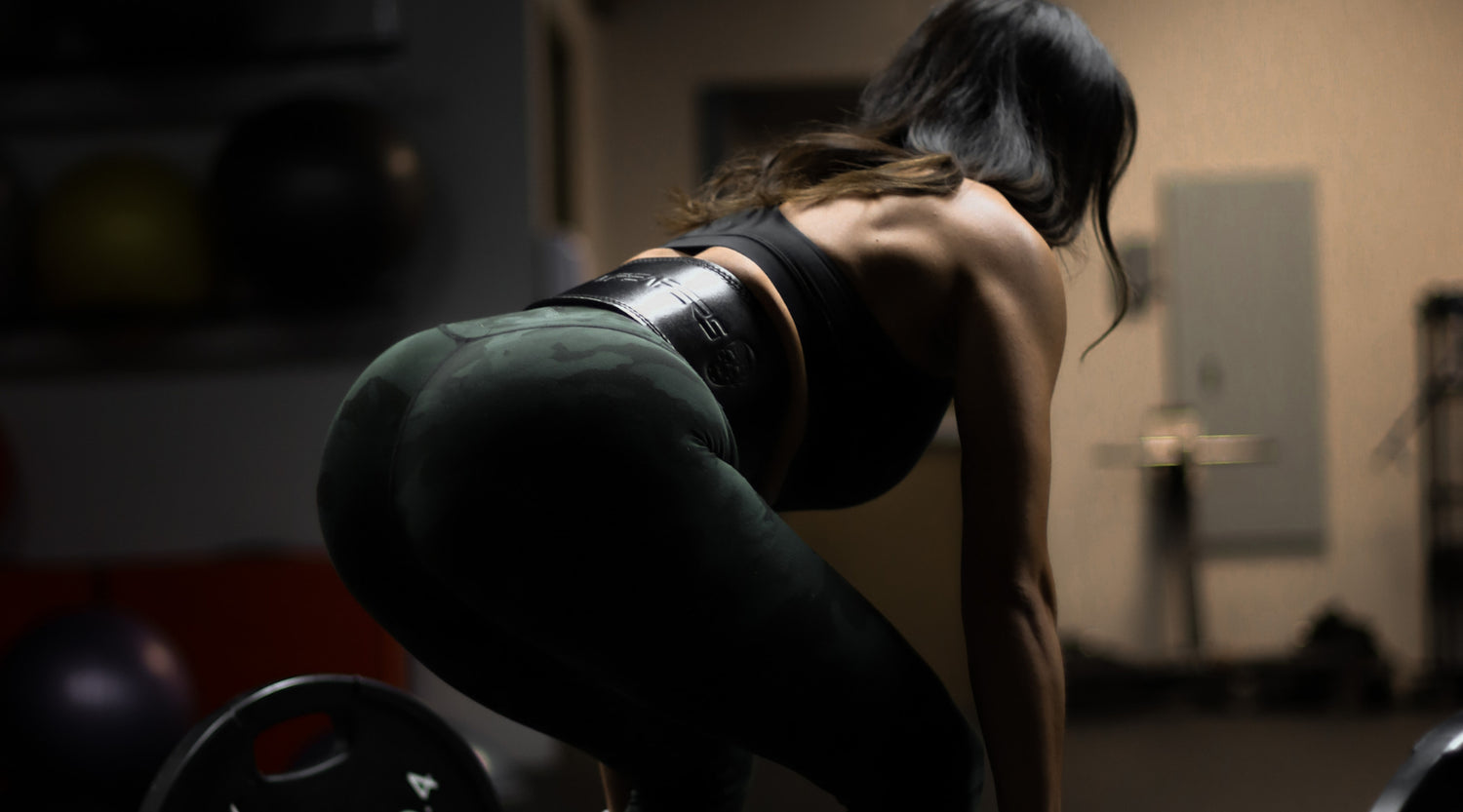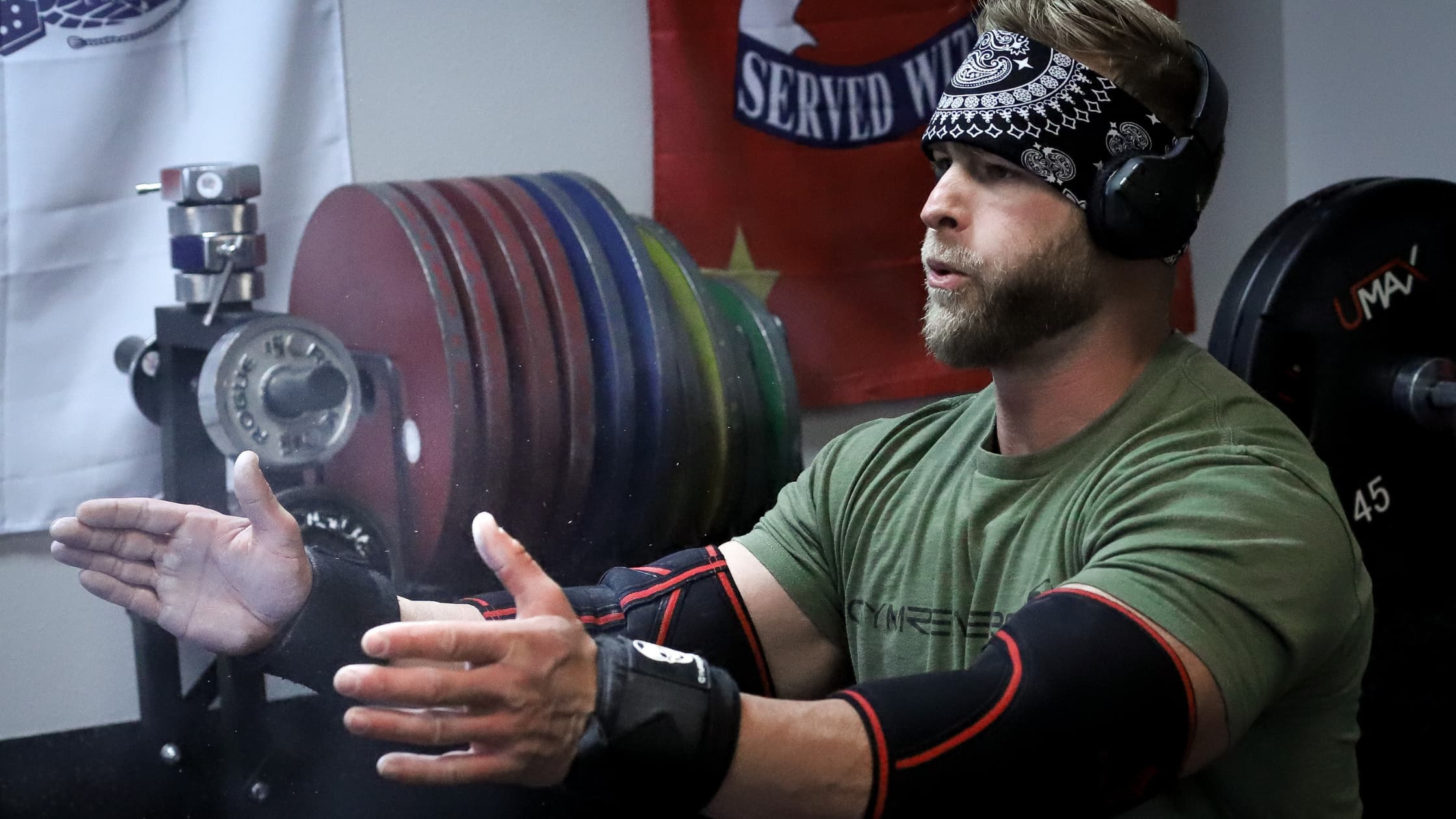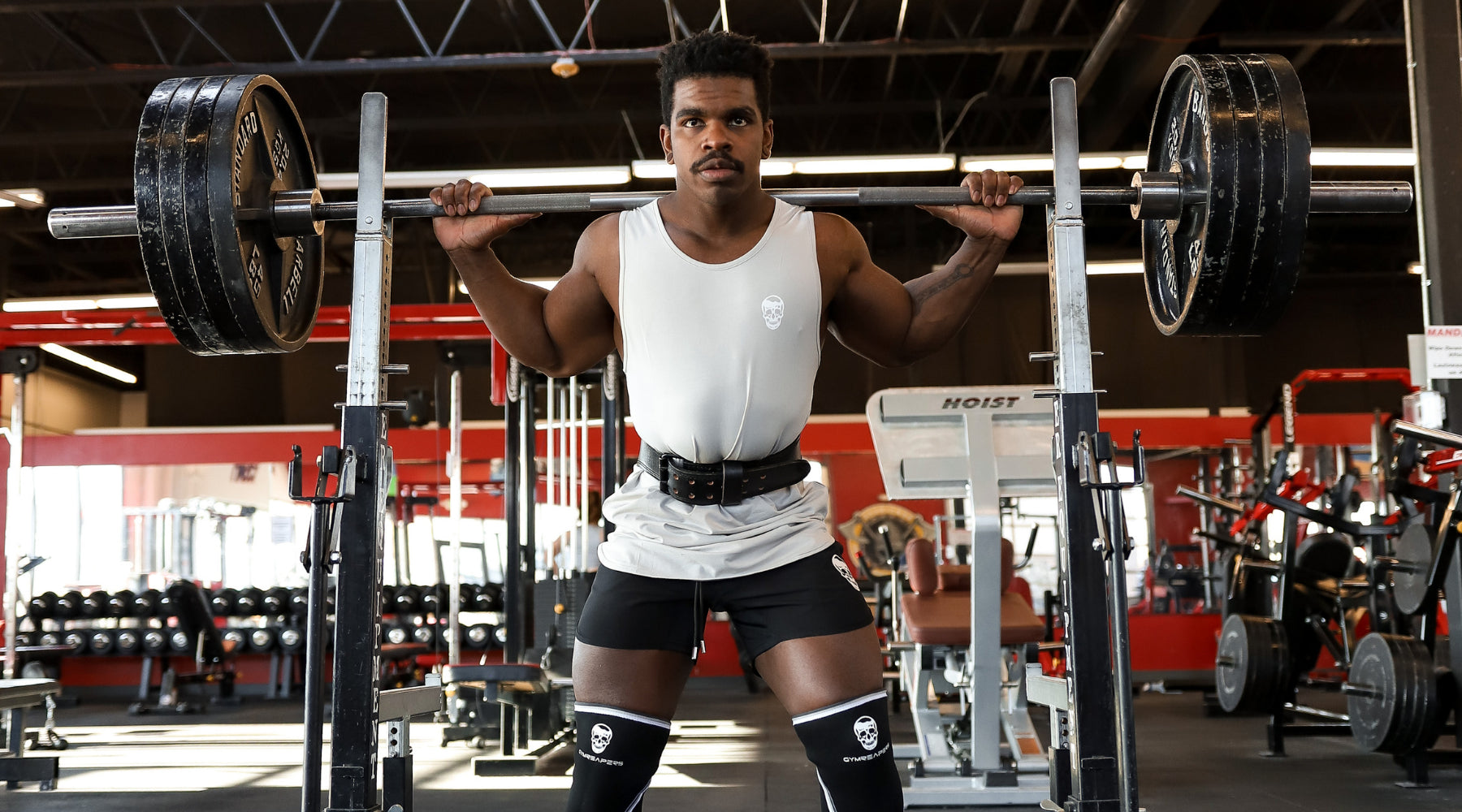The weightlifting belt is misunderstood. Most people think that using a weightlifting belt automatically protects your back, but there are other factors in play. Some think a lifting belt is dangerous, while others think wearing a belt is “cheating”. And finally, some think wearing a lifting belt will only keep you weak.
Here’s the truth: all of these beliefs are incorrect.
In today’s post, we’re going to show you why and how to use a lifting belt to build a bulletproof lower back and add pounds onto your lifts. Whether you’re a CrossFit athlete, bodybuilder, powerlifter, or Olympic Weightlifter, it’s really important to know how to use a lifting belt properly.

What’s the point of a lifting belt?
Intra-abdominal pressure is what it comes down to. Intra-abdominal pressure just means pressure or tension in your abdomen (also known as your core or midsection).
Knowing how to create intra-abdominal pressure on command is important for anyone who wants to pick up a barbell and lift.
Why? Because it’s a crucial element to lifting heavy plates without aggravating your back. The proper use of intra-abdominal pressure won’t just spare your lower back, it’ll actually make it stronger and tougher. Whether you’re a serious lifter who lives and breathes strength training, or just someone who wants to look great with their shirt off, learning how to create intra-abdominal pressure is important for a successful and pain-free lifting career.
How does intra-abdominal pressure work?
Firstly, the core’s most important job is to stay rigid so it can transfer force. For instance, you can see this concept being applied in any sport or activity. A boxer’s core transfers the force generated from the hips to their fist. A baseball player’s core transfers force from their hips to the bat. A powerlifter's core transfers force from the hips and legs into the bar.
In terms of squatting, it doesn’t matter how strong your hips and legs are if your spine collapses into a big ball of fail under the weight of the bar. This is why you can move more weight on a leg press more than you can if you’re squatting. The reason again being is that your core strength isn’t a limiting factor in the leg press as it is in the squat.
In simple terms, when you squat or deadlift, that bar wants to round your back over because that’s how gravity works. The better you can resist gravity and keep your back straight, the more weight you can lift and the happier your back will be.
How do you resist the pull of gravity and keep your posture solid? Keeping your core tight with intra-abdominal pressure so as to maintain good posture throughout the lift despite the bar’s efforts to do otherwise. Follow the logic below to make it stick in your head while you train:
More intra-abdominal pressure = more spinal rigidity = ability to lift heavier weights = more gains.
How do you create more intra-abdominal pressure?
Through the proper use of a weightlifting belt. A lifting belt works like this: when you blow up a balloon, there is pressure inside the balloon. Fill it too full of air and you create too much pressure. The balloon pops.
Now imagine tying a belt around the balloon. The balloon will pop with less air inside. This is because the air has something solid to push off. Consequently, there’s more pressure. This is effectively how a lifting belt lets you create more pressure, by giving the air you inhale something to push off of.
Now, creating intra-abdominal pressure is a technique in and of itself. I’ll go into that in a minute though. For now, the point is that when used properly, a lifting belt allows you to create more intra-abdominal pressure. This creates more tension and stiffness so you get stronger and build more muscle.

How else can you create intra-abdominal pressure?
The best way to create this pressure is through a technique called bracing, or the Valsalva maneuver. With or without a weightlifting belt, you need to learn how to brace. If you don’t brace, a belt doesn’t do anything other than give you a false sense of security. The point of a belt is simply to make bracing more effective.
So brace yourself (full pun intended) because we’re finally going to show you how to brace effectively. Again, this technique should be used whenever lifting a heavy barbell with or without a belt.
- Make sure that you’re standing.
- Put both of your hands on your rib cage.
- Inhale through your nose.
- Purse your lips and exhale through your mouth like you’re blowing out a candle, completely emptying out your lungs.
- Pay attention to how your ribs sink and deflate.
- When you have no more air left to exhale, note your rib position.
- Hold onto your rib position as you take another breath in through your nose.
- Think of breathing into your belly, obliques, and lower back. You should get a good 360-degree expansion in your midsection.
- Your abs, obliques, and low back should expand in unison.
- You should feel a really strange pressure in your midsection.
- Ta-da! Intra-abdominal pressure achievement unlocked.
- Memorize this feeling so you can replicate it when you lift.
When you’re lifting, this process will be much more streamlined. It’ll look more like this:
- Sharp and quick exhale to set your ribs into position. Own this rib position throughout the following steps.
- Nasal inhale into your core to create pressure.
- Hold onto that pressure throughout the lift.
Now, this doesn’t mean you should hold your breath throughout the set. You need to breathe or you’re going to pass out. Not ideal. You’ll need to breathe shallowly otherwise you’ll lose your hard-earned ab tension. Learning how to do shallow breathing without losing your brace takes some getting used to. You probably won’t get it right away. This is normal. Just keep practicing.
Alright, so now you know how to brace without a belt. But what about with a weightlifting belt? It’s exactly the same. The only difference is you’ll feel significantly more pressure and tension. Slap the belt on and follow the same steps as before:
- Hard and sharp exhale to set your ribs.
- Hold onto that rib position and inhale through the nose.
- As you breathe in you should feel your midsection push into every section of the belt.

How tight should my weightlifting belt be?
This question gets asked a lot and most people can’t get the setting right. You should be able to slide your open palm in between the belt and you. A lifting belt should be pretty snug, but not so tight you can’t breathe into your midsection fully.
For a lever weightlifting belt specifically, adjusting the fit of a lever can get a little tricky. Not too complicated, but as mentioned there is a lever attachment that needs to be adjusted with screws and a screwdriver. However, the same approach should be followed for the overall fit and tightness of the belt.
When should I wear my lifting belt?
Put on your belt when the weight starts getting heavy in your big compound barbell lifts. This means squats, deadlifts, military press, Olympic lifts, etc. You'll want to put your belt on during the two to three warm-up sets before your work sets -- there’s an example of this in the table below.
While you may not “need” the belt for these sets. It’s important sets to get acquainted with the belt leading up to your work sets. Here’s the example we just mentioned above. Say you’re doing 3x5 with 315 lbs being your work weight, then your workout might look something like this:
|
Weight in pounds |
Number of reps |
|
Bar (about 45 lbs) |
10 |
|
135 lbs |
8 |
|
185 lbs |
5 |
|
225 lbs |
3 |
|
245 lbs |
1 |
|
265 lbs |
1 |
|
275 lbs (with a belt on) |
1 |
|
295 lbs (with a belt on) |
1 |
Working Sets
|
Weight in pounds |
Number of reps |
|
315 lbs (with a belt on) |
5 |
|
315 lbs (with a belt on) |
5 |
|
315 lbs (with a belt on) |
5 |
Think of your warm-up sets leading up to your work sets as skill practice. Brace just as intensely on your warm-up/non-belt sets as you do on your work sets. This will build further core strength and prepare you, mentally and physically, for your work sets.
What kind of weightlifting belt should I get?
The thicker and more stiff the belt is, the harder you’ll be able to brace into it. So if you want to get the most pounds out of your belt, a thick leather belt is what you’re looking for. Most leather belts come with single prong, double prong, and lever fasteners.
That said, nylon belts are a bit more budget friendly, and fit more easily into a small gym bag. Plus, the Velcro fastener means you can get a really personalized fit. A quick-locking belt (otherwise known as a self-locking weightlifting belt) is an incredible investment for those who want a more flexible material, but still a good amount of support.
Why choose a quick locking belt?
A quick-locking weightlifting belt offers a consistent width (4-inches) all the way around, which creates even coverage for an effective lift every single time.
The best part about this belt type is that its quick-locking buckle is easy to use and will release as soon as you pull on excess velcro material and roller. Don't worry, it's very sturdy throughout your workout and won’t come undone during lifting.
Should I choose a leather belt?
If neither option from above is not your style and you're looking for firm support, then invest in a good-quality leather lifting belt is very important. A good quality leather belt features double stitching and a strong buckle for use in weightlifting, powerlifting, bodybuilding, and more. The main reason to invest in a leather belt is that allows you to lift heavier and your back will always feel better with a leather belt.

SHOP 7mm Lifting Belts
Weightlifting Belt Myths
Before wrapping up today’s post, we want to debunk the lifting belt myths we introduced at the beginning of the post. We’ve specifically left this until the end of the post because it’s easier to do so having already discussed how you’re meant to use a weightlifting belt.
1) Wearing a belt is ‘cheating’
If you aren’t strong before you put on the belt, you’re not going to magically morph into the mountain the second you put one on. We sort of have a chicken/egg thing going on here.
The belt allows you to tap into the strength you already have, letting you lift heavier weights. This, in turn, makes you even stronger without the belt. Getting strong without a belt makes you stronger with the belt.
Getting stronger with the belt makes you stronger without the belt. The point being, the belt won’t do the work for you.
2) Wearing a lifting belt will keep you weak
There’s no point in debating this. See the above section as to how this myth is complete garbage.
3) It’s dangerous and using a lifting belt automatically protects your back
Oddly enough, these two seemingly contradictory points are two sides of the same coin. It’s dangerous if you wear it and think you’re invincible. The belt is not a safeguard against poor technique.
We have seen firsthand how trainers would throw a belt on their clients whenever they complained their back was hurting during deadlifts. The client’s deadlift numbers stalled and the back pain got worse and worse the longer they followed this strategy. No surprises there.
A lifting belt is a tool that has a technique in and of itself. Wearing a belt doesn’t automatically protect your spine. If you don’t know how to use it, the belt won’t do you any good. Learn how to brace properly without the belt and you’ll get far more use with the belt.
Final thoughts
For anybody that’s serious about making progress, a weightlifting belt is one of the most important tools in your toolbox. You’ll be amazed at how much one single piece of equipment can impact your results. It’s absolutely worth the time, effort, and money to learn how to use it properly.
Whether you’re a CrossFit athlete, bodybuilder, powerlifter, or Olympic Weightlifter, it’s really important to know how to use a lifting belt properly. And now you know exactly how to get the most out of your weightlifting belt. What are you waiting for? There’s no excuse not to take advantage of the benefits of a weightlifting belt.
References
- What Is the Valsalva Maneuver?. (2022). Retrieved 26 February 2021, from https://www.webmd.com/heart-disease/atrial-fibrillation/valsalva-maneuver











1 Kommentar
James Arvin Helms
AWESOME NEEDED THANKS
Hinterlasse einen Kommentar
Alle Kommentare werden vor der Veröffentlichung geprüft.
Diese Website ist durch hCaptcha geschützt und es gelten die allgemeinen Geschäftsbedingungen und Datenschutzbestimmungen von hCaptcha.